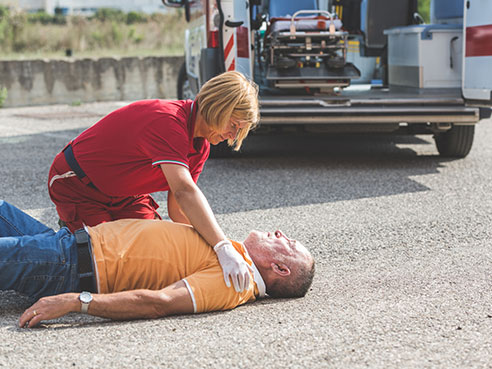 Certain heart rhythm medications, administered by paramedics to people with out-of-hospital cardiac arrest, improved the likelihood of survival during transport to a hospital, according to new research published online in the New England Journal of Medicine. The University of Alabama at Birmingham and local emergency medical services agencies participated in the study, along with other sites in the Resuscitation Outcomes Consortium, which includes clinical sites in the United States and Canada. ROC is funded by the National Institutes of Health.
Certain heart rhythm medications, administered by paramedics to people with out-of-hospital cardiac arrest, improved the likelihood of survival during transport to a hospital, according to new research published online in the New England Journal of Medicine. The University of Alabama at Birmingham and local emergency medical services agencies participated in the study, along with other sites in the Resuscitation Outcomes Consortium, which includes clinical sites in the United States and Canada. ROC is funded by the National Institutes of Health.
The study looked at two antiarrhythmic medications, amiodarone and lidocaine, given by paramedics in the field, and followed patients from hospital admission to hospital discharge. Compared with placebo, the use of amiodarone and lidocaine resulted in 5 percent higher survival in cases where a bystander witnessed the patient’s collapse. Bystander-witnessed survival rates are higher than nonwitnessed rates, due to the increased likelihood of bystander CPR and faster EMS response. This is an important figure, especially considering that only about one-fourth of bystander-witnessed cardiac arrest patients survive.
Sudden cardiac arrest is a condition in which the heart suddenly or unexpectedly stops beating, cutting off blood flow to the brain and other vital organs. More than 300,000 people are treated for out-of-hospital cardiac arrest each year, with the vast majority occurring at home, according to the American Heart Association. Effective treatments, such as CPR and defibrillation, can greatly increase a victim’s chance of survival. This study adds the possibility of additional benefit from the use of the heart rhythm medications.
Antiarrhythmic drugs are commonly given by EMS providers in cases of cardiac arrest that is not responsive to defibrillation, but there was no consensus on whether they actually improved survival.
| Overall, the trial was conducted in 10 cities and examined more than 3,000 patients who underwent out-of-hospital cardiac arrest caused by ventricular fibrillation and ventricular tachycardia, life-threatening rhythms of the heart’s lower pumping chambers that are often resistant to electrical shock. |
The three-year study, which was led locally by Henry Wang, M.D., vice chair for Research in the UAB Department of Emergency Medicine, involved five local EMS agencies. Overall, the trial was conducted in 10 cities and examined more than 3,000 patients who underwent out-of-hospital cardiac arrest caused by ventricular fibrillation and ventricular tachycardia, life-threatening rhythms of the heart’s lower pumping chambers that are often resistant to electrical shock.
“Overall survival from out-of-hospital cardiac arrest is low — on the order of 10 percent. Any strategy that can boost that rate is worth examining,” Wang said.
Local EMS agencies participating with UAB in the study were Birmingham Fire and Rescue, Bessemer Fire Department, Hoover Fire Department, Centerpoint Fire District and Regional Paramedical Services in Walker and St. Clair Counties.
Funding for this study was provided by the National Heart, Lung and Blood Institute in partnership with the U.S. Army Medical Research & Material Command, the Canadian Institutes of Health Research, the Heart and Stroke Foundation of Canada, and the American Heart Association. The study was presented at the American College of Cardiology 2016 Scientific Sessions in Chicago.
EMS agencies and receiving hospitals that participated in this trial are located in: Birmingham, Alabama; Vancouver, British Columbia; Dallas-Fort Worth; Seattle-King County; Milwaukee; Ottawa-OPALS Group, Ontario; Toronto; Portland, Oregon; San Diego; and Pittsburgh.